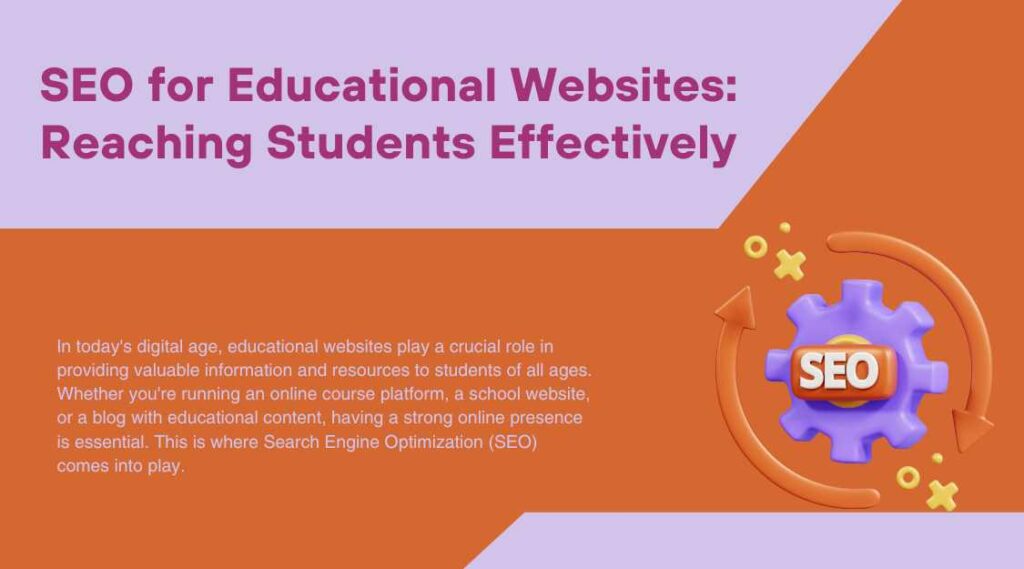
SEO for Educational Websites: Reaching Students Effectively
In today’s digital age, educational websites play a crucial role in providing valuable information and resources to students of all ages. Whether you’re running an online course platform, a school website, or a blog with educational content, having a strong online presence is essential. This is where Search Engine Optimization (SEO) comes into play. In this blog post, we’ll explore how SEO can help educational websites reach students effectively and provide some actionable tips to improve your website’s visibility on search engines.
When it comes to optimizing educational websites for better search engine visibility, partnering with a professional SEO agency can make a significant difference. For example, an SEO agency in Dubai can bring a wealth of local and international SEO expertise to the table. They understand the unique challenges and opportunities in the educational sector and can tailor their strategies to meet your specific needs. From keyword research to on-page optimization and backlink building, a reputable SEO agency can help your educational website climb the search engine rankings and attract more students who are actively seeking the educational content and resources you provide. So, if you’re looking to enhance your online presence and reach a wider audience of eager learners, consider the expertise of an SEO agency in Dubai to give your educational website the competitive edge it deserves.
Why SEO Matters for Educational Websites
Before we dive into the strategies, let’s understand why SEO is vital for educational websites:
1. Increased Visibility
The internet is vast, and millions of websites compete for attention. SEO helps your educational website stand out by optimizing it for search engines like Google. More students can discover and access your valuable educational content when your site ranks higher in search results.
2. Enhanced Credibility
Websites that appear at the top of search results are often perceived as more trustworthy and credible. By optimizing your website for SEO, you can establish your educational platform as a reliable source of information, attracting more students and educators.
3. Better User Experience
SEO isn’t just about keywords and rankings; it also involves improving the overall user experience. Websites that load quickly, have intuitive navigation, and provide valuable content are more likely to retain visitors and keep them engaged with your educational materials.
4. Cost-Effective Marketing
Compared to traditional advertising methods, SEO is a cost-effective way to promote your educational website. By optimizing your site for relevant keywords, you can attract organic traffic without the need for constant advertising spend.
SEO Strategies for Educational Websites
Now that we understand the importance of SEO for educational websites, let’s explore some actionable strategies to help you reach students effectively:
1. Keyword Research
Keyword research is the foundation of any successful SEO strategy. Identify relevant keywords and phrases students will likely use when searching for educational content. Tools like Google Keyword Planner can assist you in finding valuable keywords with high search volumes and low competition.
2. High-Quality Content
Creating high-quality, informative, and engaging content is key to attracting and retaining students. Whether it’s articles, videos, or interactive quizzes, ensure your content provides value and answers students’ questions. Use your chosen keywords naturally within the content to improve its SEO.
3. On-Page SEO
Optimize your website’s on-page elements, including titles, headings (H1, H2, H3), meta descriptions, and image alt text. Ensure that each page focuses on a specific topic and uses relevant keywords appropriately. This helps search engines understand your content’s relevance and rank it accordingly.
4. Mobile-Friendly Design
With the increasing use of smartphones and tablets, it’s crucial to have a mobile-friendly website. Google prioritizes mobile-responsive websites in its search rankings. Ensure that your site is accessible and user-friendly on all devices.
5. Page Load Speed
A fast-loading website not only improves user experience but also boosts SEO rankings. Use tools like Google PageSpeed Insights to identify and fix performance issues that may slow down your website.
6. Internal Linking
Internal linking helps users navigate your website and also distributes the SEO value throughout your content. Link related articles and pages within your website to keep visitors engaged and encourage them to explore more of your educational resources.
7. Build Backlinks
Earning high-quality backlinks from reputable websites can significantly improve your SEO. Reach out to educational institutions, influencers, and other relevant websites for guest posting opportunities or collaborations that can lead to valuable backlinks.
8. Local SEO
Optimize your website for local SEO if you offer educational services in a specific location. Create a Google My Business profile, include your address, phone number, and operating hours. Encourage satisfied students to leave reviews, as positive feedback can improve your local search rankings.
9. Monitor and Analyze
Regularly monitor your website’s performance using tools like Google Analytics and Google Search Console. Analyze your traffic, keyword rankings, and user behaviour to identify areas for improvement and adjust your SEO strategy accordingly.
Standard SEO Mistakes to Avoid
In your quest to optimize your educational website for better visibility, here are some common mistakes to avoid:
1. Keyword Stuffing
Overloading your content with keywords can make it unnatural and difficult to read. Focus on creating valuable content and use keywords naturally where they fit.
2. Ignoring User Experience
A poor user experience, such as slow loading times and confusing navigation, can lead to higher bounce rates and lower rankings. Prioritize a user-friendly design and fast page load times.
3. Neglecting Mobile Optimization
With most internet users on mobile devices, neglecting mobile optimization can significantly lose potential students.
4. Not Updating Content
Outdated content can harm your SEO rankings. Regularly update and refresh your educational materials to keep them relevant and informative.
Conclusion
SEO is a powerful tool for educational websites looking to reach students effectively. By implementing the abovementioned strategies and avoiding common SEO mistakes, you can improve your website’s visibility, credibility, and user experience. Remember that SEO is an ongoing process; staying up-to-date with the latest SEO trends and algorithms is essential for long-term success. Invest in SEO and watch your educational website rise in the rankings, ultimately reaching and helping more students in their educational journey.







